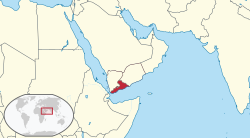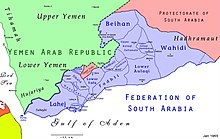| Revision as of 19:11, 18 February 2024 editEddiejames1948 (talk | contribs)176 editsNo edit summaryTags: Reverted Mobile edit Mobile web edit← Previous edit | Revision as of 01:20, 19 February 2024 edit undoVif12vf (talk | contribs)Extended confirmed users80,586 edits Restored revision 1200880788 by YKSBS (talk): Currently no information present that supports a parliamentary and constitutional form of government.Tags: Twinkle UndoNext edit → | ||
| Line 9: | Line 9: | ||
| |status = British ] | |status = British ] | ||
| |empire = United Kingdom | |empire = United Kingdom | ||
| |government_type = ] ] ] | |government_type = ] | ||
| |title_leader = | |title_leader = | ||
| |leader1 = | |leader1 = | ||
Revision as of 01:20, 19 February 2024
1962–1967 British protectorate in southwest Arabia For the history of the Federation, see History of Yemen.| Federation of South Arabiaاتحاد الجنوب العربي Ittiḥād al-Janūb al-‘Arabī | |||||||||||||
|---|---|---|---|---|---|---|---|---|---|---|---|---|---|
| 1962–1967 | |||||||||||||
 Flag
Flag
 Emblem
Emblem
| |||||||||||||
 | |||||||||||||
| Status | British protectorate | ||||||||||||
| Capital | Aden | ||||||||||||
| Common languages | Arabic English South Arabian | ||||||||||||
| Government | Federal monarchy | ||||||||||||
| High Commissioner | |||||||||||||
| • 1963 | Sir Charles Johnston | ||||||||||||
| • 1963–1964 | Sir Kennedy Trevaskis | ||||||||||||
| • 1964–1967 | Sir Richard Turnbull | ||||||||||||
| • 1967 | Sir Humphrey Trevelyan | ||||||||||||
| Chief Minister | |||||||||||||
| • 1963 | Hassan Ali Bayumi | ||||||||||||
| • 1963–1965 | Zayn Abdu Baharun | ||||||||||||
| • 1965 | Abdul-Qawi Hassan Makkawi | ||||||||||||
| • 1965–1966 | Ali Musa al-Babakr | ||||||||||||
| • 1966–1967 | Salih al-Awadli | ||||||||||||
| Historical era | Cold War | ||||||||||||
| • Established | 4 April 1962 | ||||||||||||
| • Independence | 30 November 1967 | ||||||||||||
| Currency | South Arabian dinar | ||||||||||||
| |||||||||||||


The Federation of South Arabia (FSA; Template:Lang-ar Ittiḥād al-Janūb al-‘Arabī) was a federal state under British protection in what would become South Yemen. Its capital was Aden.
History
It was formed on 4 April 1962 from the 15 protected states of the Federation of Arab Emirates of the South. The State of Aden, formerly Aden Colony, joined the Federation on 18 January 1963. In June 1964, the Upper Aulaqi Sultanate was added for a total of 17 states. A team was sent to the 1966 Commonwealth Games in Kingston, Jamaica. The Federation was abolished on 30 November 1967, when its status as a British protectorate came to an end, along with that of the Protectorate of South Arabia, and they became the People's Democratic Republic of Yemen.
States
| Flag | Name | Established | Joined | Notes |
|---|---|---|---|---|

|
State of Aden | 1963 | ||
 |
Alawi Sheikhdom | unknown | ||
 |
Aqrabi Sheikhdom | 1770 | ||

|
Audhali Sultanate | 18th century | ||

|
Emirate of Beihan | 1680 | ||

|
Dathina Sheikhdom | 18th century | ||

|
Emirate of Dhala | early 19th century | ||

|
Fadhli Sultanate | 17th century | ||

|
Haushabi Sultanate | 18th century | ||

|
Sultanate of Lahej | 1728 | 1872 | formerly ruled over Aden |
 |
Lower Aulaqi Sultanate | 18th century | ||

|
Sultanate of Lower Yafa | ca. 1800 | ||

|
Muflahi Sheikhdom | 1850 | ||

|
Sheikhdom of Shaib | 18th century | ||

|
Upper Aulaqi Sheikhdom | 18th century | ||

|
Upper Aulaqi Sultanate | 18th century | ||

|
Wahidi Sultanate | 1830 | consisted originally of four sub-sultanates: Wahidi Balhaf, Wahidi Azzan, Wahidi Bir Ali, Wahidi Haban |
List of rulers
| State | Last Ruler | Deposed | House | Reign | Ref(s) |
|---|---|---|---|---|---|
| Salih ibn Sayil | 28 August 1967 | Al Alawi | Last reigning Sheikh (1940–1967). | ||
| Mahmud ibn Muhammad | 28 August 1967 | Al Aqrabi | Last reigning Sheikh (1957–1967). | ||
| Salih ibn al-Husayn | 17 September 1967 | Al Audhali | Last reigning Sultan (1928–1967). | ||
| Nasir ibn Aidrus | 29 November 1967 | Al Awlaqi | Last reigning Sultan (1947–1967). | ||
| Awad ibn Salih | 29 November 1967 | Al Awlaqi | Last reigning Sultan (1935–1967). | ||
| Saleh bin al-Husayn | 28 August 1967 | Al Habieli | Last reigning Emir (1935–1967). | ||
| Shafaul ibn Ali Shaif | 17 August 1967 | Al Amiri | Last reigning Emir (1954–1967). | ||
| Nasir bin Abdullah | 29 November 1967 | Al Fadhli | Last reigning Sultan (1964–1967). | ||
| Faisal bin Surur | 29 November 1967 | Al Haushabi | Last reigning Sultan (1955–1967). | ||
| Fadhl VI bin Ali | 17 August 1967 | Al Abdali | Last reigning Sultan (1958–1967). | ||
| Ali ibn Muhammad | 17 August 1967 | Al Wahidi | Last governing Hakim (1967). | ||
| Alawi ibn Salih | 29 November 1967 | Last reigning Sultan (1955–1967). | |||
| Husayn ibn Abdullah | 29 November 1967 | Last reigning Sultan (until 1967). | |||
| Mahmud ibn Aidrus | 28 August 1967 | Al Afifi | Last reigning Sultan (1954–1967). |
- Prior to his formal ascension to the throne, he had served as prince regent since 10 July 1958.
- Known as Balhaf and Azzan from 1881, signifying Balhaf's merge with Wahidi Azzan. Known simply as Wahidi from 1962, when the sultanates of Wahidi Bir Ali and Wahidi Haban were made subordinate.
- Prince Ali held the position of hakim (regent) from 20 February 1967 until the sultanate's abolition in August of the same year. He was never crowned sultan.
- Alawi previously reigned as sultan from 1955 until the monarchy was abolished in 1967. Before his reign ended, he was made subordinate to the Sultan of Balhaf and Azzan on 23 October 1962.
- Husayn had previously reigned as sultan prior to the monarchy's abolition in 1967. Before his reign ended, he was made subordinate to the Sultan of Balhaf and Azzan on 23 October 1962.
- Mahmud previously reigned as sultan from 1954 until the monarchy was deposed in 1967. His reign was not initially recognised by the British government, which continued to recognise his still-living father and predecessor as sultan until 1958.
- A clan of the Yafa tribe. The Yafai are divided into ten sheikhdoms that were spread across the former sultanates of Lower Yafa and Upper Yafa.
Chief Ministers
- Hassan Ali Bayumi (18 January 1963 – 24 June 1963)
- Zayn Abdu Baharun (9 July 1963 – 23 January 1965)
- Abdul-Qawi Hassan Makkawi (7 March 1965 – 25 September 1965)
- Ali Musa al-Babakr (25 September 1965 – 30 August 1966)
- Salih al-Awadli (30 August 1966 – 30 November 1967)
High Commissioners
Main article: List of British representatives at Aden- Sir Charles Johnston (18 January 1963 – 17 July 1963)
- Sir Kennedy Trevaskis (17 July 1963 – 21 December 1964)
- Sir Richard Turnbull (21 December 1964 – 22 May 1967)
- Sir Humphrey Trevelyan (22 May 1967 – 30 November 1967)
Postage stamps

The Federation issued its own Adeni postage stamps from 1963 to 1966. Most of its issues were part of the omnibus issues common to all the Commonwealth territories, but it did issue its own definitive stamps on 1 April 1965. The set of 14 included 10 values, from 5 to 75 fils, each depicting the arms of the Federation in a single color, while the top four values (100 fils, 250 fils, 500 fils, and 1 dinar), featured the flag of the Federation.
The stamps referred to above are those listed in the Scott Standard Postage Stamp Catalog. A number of other stamps have also been issued and are listed in Stanley Gibbons and other widely used stamp catalogs. It is possible, or even likely, that some of the stamps of South Arabia were not issued primarily for postal use.
See also
References
- Parliament Building in Al Ittihad, the capital of the Federation of South Arabia
- ^ Cahoon, Ben. "States of the Aden Protectorates". World Statesmen.org. Retrieved 27 April 2010.
- A Collection of First World War Military Handbooks of Arabia, 1913–1917. Vol. 3. Archive Editions. 1988. pp. 84–93. ISBN 978-1-85207-086-1.
Further reading
- Paul Dresch. A History of Modern Yemen. Cambridge, UK: Cambridge University Press, 2000.
- R.J. Gavin. Aden Under British Rule: 1839-1967. London: C. Hurst & Company, 1975.
- Tom Little. South Arabia: Arena of Conflict. London: Pall Mall Press, 1968.
External links
 Media related to Federation of South Arabia at Wikimedia Commons
Media related to Federation of South Arabia at Wikimedia Commons- South Arabia and Yemen, 1945-1995
| Former states in South Arabia | |
|---|---|
| Federation of South Arabia | |
| Protectorate of South Arabia | |
| Independent states | |
15°19′48″N 48°04′34″E / 15.330°N 48.076°E / 15.330; 48.076
Categories: